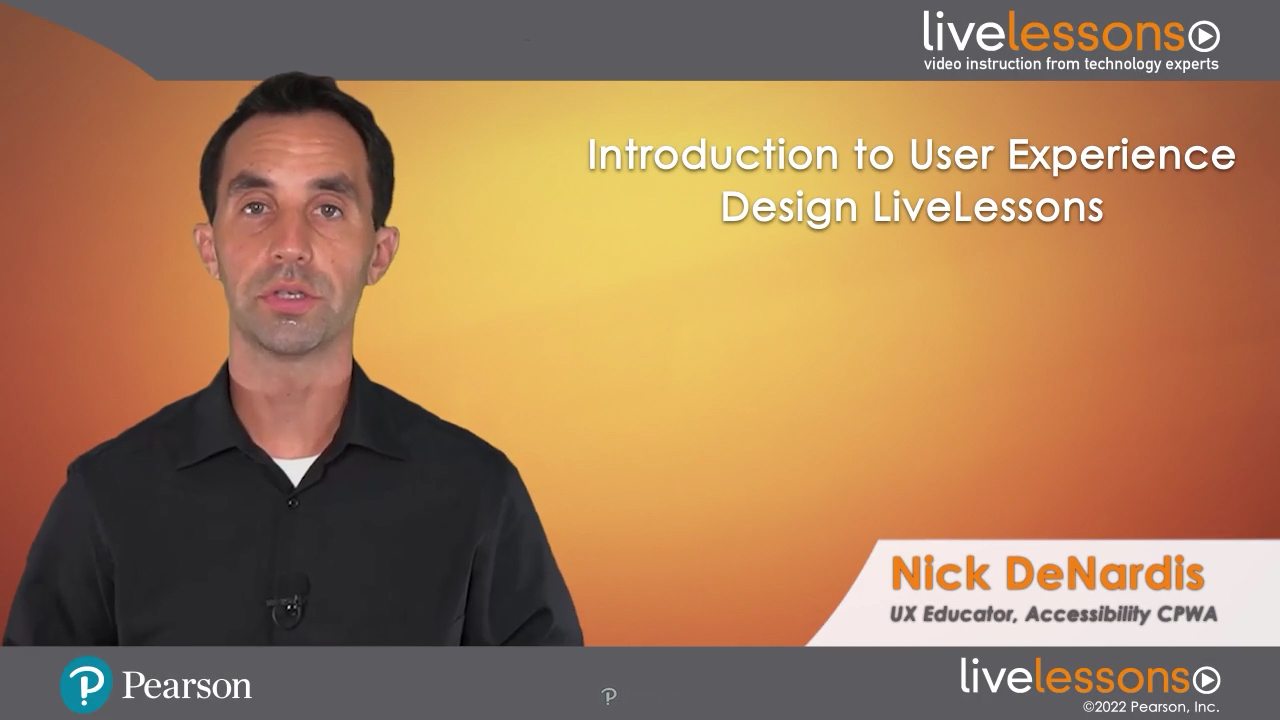Introduction to User Experience Design LiveLessons (Video Training)
- By Nick DeNardis
- Published Oct 27, 2021 by Addison-Wesley Professional.

Online Video
- Your Price: $239.99
- List Price: $299.99
- About this video
Video accessible from your Account page after purchase.
Register your product to gain access to bonus material or receive a coupon.
Description
- Copyright 2022
- Edition: 1st
- Online Video
- ISBN-10: 0-13-753449-3
- ISBN-13: 978-0-13-753449-4
8+ Hours of Video Instruction
This LiveLessons video course introduces the principles of user experience design to new or seasoned developers. It covers the terms, roles, responsibilities, and how to build products with users in mind.
Description
Happy users are a company's biggest advocates. Every interaction a user has with a website or an app contributes to the user experience. Introduction to User Experience Design LiveLessons uncovers the opportunities and processes to creating exceptional user experiences to delight your users.
This course is for anyone involved with the creation of websites or apps that are used by end users. It focuses on the web page, app experience, showing various website examples that are either viewed in a browser or as screenshots, illustrating effective design and considering multiple ways to interact with a site based on different motivations.
Skill Level
- Beginner to Intermediate
What You Will Learn
- Understand what makes a website/app usable
- Learn common patterns that users look for
- Measure the success of a site/app
- Perform A/B tests to increase the usability of a site/app
- Sell design or implementation changes to team members based on data
Who Should Take This Course
- Primary: Web developers, UI designers, UX designers
- Secondary: Web product managers
Course Requirements
- Basic comfort level creating web sites or apps, or have a high level understanding of the process.
About Pearson Video Training
Pearson publishes expert-led video tutorials covering a wide selection of technology topics designed to teach you the skills you need to succeed. These professional and personal technology videos feature world-leading author instructors published by your trusted technology brands: Addison-Wesley, Cisco Press, Pearson IT Certification, Sams, and Que. Topics include IT Certification, Network Security, Cisco Technology, Programming, Web Development, Mobile Development, and more. Learn more about Pearson Video training at http://www.informit.com/video.
Video Lessons are available for download for offline viewing within the streaming format. Look for the green arrow in each lesson.
Sample Content
Table of Contents
Introduction
Lesson 1: Understand Core Concepts of User Experience
Learning Objectives
1.1 Dive into terms
1.2 Understand the technology, business, and design of UX
1.3 Explore roles and responsibilities
1.4 Get into the UX mindset
Lesson 2: Review Principles of Interaction Design
Learning Objectives
2.1 Learn Jakob Nielsen's 10 principles for interaction design
2.2 Visibility of system status
2.3 Match between system and the real world
2.4 User control and freedom
2.5 Consistency and standards
2.6 Error prevention
2.7 Recognition rather than recall
2.8 Flexibility and efficiency of use
2.9 Aesthetic and minimalist design
2.10 Help users recognize, diagnose, and recover from errors
2.11 Help and documentation
Lesson 3: Walk Through the UX Process
Learning Objectives
3.1 Build user-centered thinking
3.2 Learn the different UX disciplines
3.3 Lower the cognitive friction
3.4 Explore a case study: internal customer-service tool
Lesson 4: Discover UX Myths and Pitfalls
Learning Objectives
4.1 Understand UX != UI
4.2 Explore the myth: Only UX professionals can improve the user experience
4.3 Explore the pitfall: User feature requests translate to good UX
4.4 Discover lazy or messy user interfaces
Lesson 5: Create UX Artifacts
Learning Objectives
5.1 Create user flow
5.2 Craft sketches
5.3 Build wireframes
5.4 Add design
5.5 Finish with implementation
5.6 Explore a case study: coffee-shop website where users can subscribe to coffee of the day
Lesson 6: Change the User Experience
Learning Objectives
6.1 Learn the three pillars: Happy, Satisfied, and Productive
6.2 Discover you are not the user
6.3 Giving users a path forward
Lesson 7: Explore Case Studies
Learning Objectives
7.1 Explore a case study: URL shortener application, VR Tour website and app
7.2 Explore a case study: Landing page
7.3 Explore a case study: College of Education redesign
Lesson 8: Discover Visual Design Patterns
Learning Objectives
8.1 See UI shapes, recognition versus recall
8.2 Add whitespace, grouping, and alignment
8.3 Experience animation, changes, and user feedback
8.4 Add colors and contrast
8.5 Build progressive disclosure
Lesson 9: Conduct A/B and Multivariant Tests
Learning Objectives
9.1 Explore the process
9.2 Build a test
9.3 Analyze the results
9.4 Iterate
9.5 Learn why not everything can be tested
9.6 Explore limitations of iterative design
Lesson 10: Make the Business Case for Changes
Learning Objectives
10.1 Understand the business
10.2 Use user research at multiple points in the process
10.3 Sell design systems
10.4 Explore options for in-person research
10.5 Explore options for online research
10.6 Present tests and results
Lesson 11: Avoid Dark Patterns
Learning Objectives
11.1 Learn dark patterns
11.2 Craft user-focused defaults
11.3 Build in security and privacy
11.4 Understand business goals versus user goals
Lesson 12: Get a Fresh Perspective
Learning Objectives
12.1 Evaluate design from the outside in
12.2 Explore alternative input and output devices
12.3 Test on physical devices
Lesson 13: Apply the Principles
Learning Objectives
13.1 Start with UX principles
13.2 Discover UX in action
13.3 Test and refine UX
Summary
More Information
